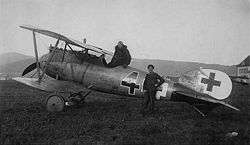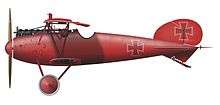Albatros D.V
| Albatros D.V | ||
|---|---|---|
 | ||
| Albatros D.Va reproduction at Duxford Air Show, 2012 | ||
| Role | Fighter | |
| Manufacturer | Albatros-Flugzeugwerke | |
| Designer | Robert Thelen | |
| First flight | April 1917 | |
| Primary user | Luftstreitkräfte | |
| Number built | approximately 2500 | |
|
|} The Albatros D.V was a fighter aircraft used by the Luftstreitkräfte (Imperial German Air Service) during World War I. The D.V was the final development of the Albatros D.I family, and the last Albatros fighter to see operational service. Despite its well-known shortcomings and general obsolescence, approximately 900 D.V and 1,612 D.Va aircraft were built before production halted in early 1918. The D.Va continued in operational service until the end of the war. Design and development Captured Albatros D.V (serial D.1162/17) with British roundels  Manfred von Richthofen's Albatros D.V (serial unknown) In April 1917, Albatros received an order from the Idflieg (Inspektion der Fliegertruppen) for an improved version of the D.III. The resulting D.V prototype flew later that month. The D.V closely resembled the D.III and used the same 127 kW (170 hp) Mercedes D.IIIa engine. The most notable difference was a new, fully elliptical cross-section fuselage which was 32 kg (70 lb) lighter than the partially flat-sided fuselage of the earlier D.I through D.III designs.[1] The new elliptical cross-section required an additional longeron on each side of the fuselage. The vertical fin and tailplane initially remained unchanged from the D.III.[1] The prototype D.V retained the standard rudder of the Johannisthal-built D.III, but production examples used the enlarged rudder featured on D.IIIs built by Ostdeutsche Albatros Werke (OAW).[2] The D.V also featured a larger spinner and ventral fin. Compared to the D.III, the upper wing of the D.V was repositioned 4.75 inches closer to the fuselage, while the lower wings attached to the fuselage without a fairing. The D.V's wings themselves were almost identical to those of the standard D.III, which had adopted a sesquiplane wing arrangement broadly similar to the French Nieuport 11. The only significant difference between wings of the D.III and D.V was a revised linkage of the aileron cables, which in the new aircraft was contained entirely in the upper wing.[3] Idflieg therefore conducted structural tests on the fuselage, but not the wings, of the D.V.[4] Early examples of the D.V featured a large headrest, which was usually removed in service because it interfered with the pilot's field of view.[3] The headrest was eventually deleted from production. Aircraft deployed in Palestine used two wing radiators, to cope with the warmer climate. Idflieg issued production contracts for 200 D.V aircraft in April 1917, followed by additional orders of 400 in May and 300 in July.[4] Initial production of the D.V was exclusively undertaken by the Johannisthal factory, while the Schneidemühl factory produced the D.III through the remainder of 1917. Operational history Albatros D.Va (serial D.7098/17)  Albatros D.Va (serial D.5629/17) The D.V entered service in May 1917 and, like the D.III before it, immediately began experiencing structural failures of the lower wing.[4] Indeed, anecdotal evidence suggests that the D.V was even more prone to wing failures than the D.III. The outboard sections of the upper wing also suffered failures, requiring additional wire bracing.[4] Furthermore, the D.V offered very little improvement in performance.[3] This caused considerable dismay among frontline pilots, many of whom preferred the older D.III. Manfred von Richthofen was particularly critical of the new aircraft. In a July 1917 letter, he described the D.V as "so obsolete and so ridiculously inferior to the English that one can't do anything with this aircraft." British tests of a captured D.V revealed that the aircraft was slow to maneuver, heavy on the controls, and tiring to fly.[5] Albatros responded with the D.Va, which featured stronger wing spars, heavier wing ribs, and a reinforced fuselage.[6] These modifications made the D.Va 23 kg (50 lb) heavier than the D.III, while failing to cure entirely the structural problems of the type. Use of the high-compression 130 kW (180 hp) Mercedes D.IIIaü engine offset the increased weight of the D.Va.[7] The D.Va also reverted to the D.III's aileron cable linkage, running outwards through the lower wing, then upwards to the ailerons, to provide a more positive control response.[3] The wings of the D.III and D.Va were in fact interchangeable.[3] The D.Va was also fitted with a small diagonal brace connecting the lower section of the forward interplane strut to the leading edge of the lower wing. This brace was retrofitted to some D.V aircraft.[7] Idflieg placed orders for 262 D.Va aircraft in August 1917, followed by additional orders for 250 in September and 550 in October.[6] Ostdeutsche Albatros Werke, which had been engaged in production of the D.III, received orders for 600 D.Va aircraft in October.[6] Deliveries of the D.Va commenced in October 1917.[6] The structural problems of the Fokker Dr.I and the mediocre performance of the Pfalz D.III left the Luftstreitkräfte with no viable alternative to the D.Va until the Fokker D.VII entered service in mid-1918. Production ceased in April 1918.[8] As of May 1918, 131 D.V and 928 D.Va aircraft were in service on the Western Front. This number declined as the Albatros was replaced by Fokker D.VIIs and other types during the final months of the war, but the D.Va remained in use until the Armistice (11 November 1918). Survivors D.Va (serial D.5390/17) on display at the Australian War Memorial in Canberra Today, two D.Va aircraft survive in museums.
Operators
Specifications (D.V) Official Albatros D.V Baubeschreibung drawing, submitted to IdFlieg Data from German Aircraft of the First World War[11] General characteristics
Performance
Armament
Gallery
See also
References
External links
| ||





